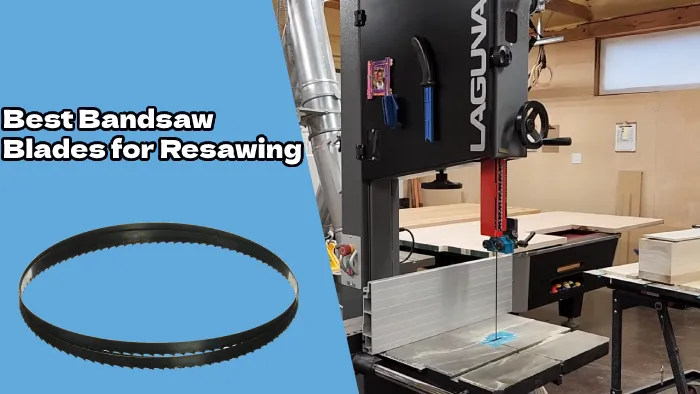
Do you find resawing hardwood with your bandsaw a challenge? Unlock the full potential of your bandsaw with the best bandsaw blade for resawing. But there are many factors to take into account when choosing resaw blades.
When selecting the most effective blade for resawing to ensure smooth and precise cuts, choose the blade material carefully. It is also recommended to consider the blade’s TPI. Aside from that, consider blade thickness, as this offers more straight cuts.
Today we’ll discuss the top 5 recommended bandsaw blades for your resawing task. We will also provide you with the knowledge and expertise to choose the most appropriate bandsaw blade for resawing hardwood. Whatever your woodworking experience, we have something for you. So continue reading.
Review of Five Best Bandsaw Blades for Resawing
Bandsaw blades are essential tools, but not all blades are the same. To help you find an ideal bandsaw blade for resawing, we’ve compiled a list of the top five blades available today.
We aim to tell you about product features, pros and cons, and how these products can benefit you. Our in-depth review guide will let you know which blade is right for you and your needs.
Following are the five recommended band saw blades for resawing for your needs:
#1 Olson Saw TPI Hook Saw Blade for Resawing
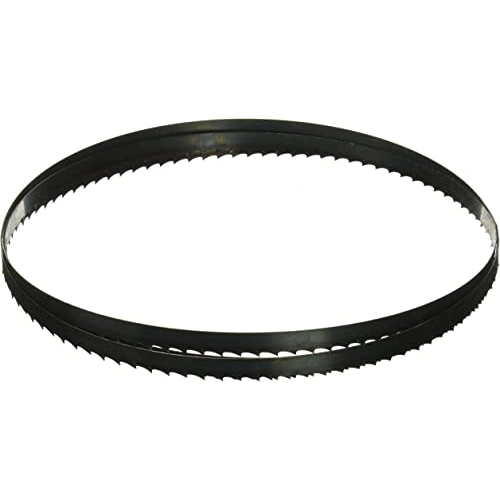
Introducing the Olson Saw TPI hook resaw blade, the ultimate bandsaw blade for industrial, woodworking, DIY, and professional craftsmen. It’s not just durable and versatile. It’s also really cheap.
Easy to Install and Handle
One of the key advantages of the resaw blade is its easy installation and handling. You do not need any special skills or tools to set up this bandsaw blade and get it working.
It seamlessly fits into all vertical, stationary, floor-standing 2-wheel band saws. So it is universally compatible with cutting and resawing different materials.
Durable and Versatile
Another notable feature of the resawing Blade is its high durability and versatility. Unlike other blades, this product can easily cut through hard or soft wood, mild steel, and non-ferrous metals.
Its tooth and back hardness levels of 62-63rc and 28-32rc, respectively, make it a sturdy and robust option for different cutting applications.
Fast and Precise Cutting
With its 3 TPI hook design, this great blade can cut through various materials quickly and accurately. This fewer teeth product can handle different types of wood and metal and easily produce clean, straight cuts.
Whether you are a professional, DIY enthusiast, or home woodworker, this blade can help you achieve exceptional cutting results.
Great Value for Money
The blade offers great value for ripping and resawing cuts. Compared to other band saw blades, this product is relatively affordable and delivers high-quality performance.
Pros:
- Easy installation and handling
- Durable and versatile
- Fast and straight cutting
- Compatible with various materials
- Great value for money
Cons:
- Poor welds might cause fractures over time
#2 Timber Wolf 1/2-inch Band Saw Blades
For smoother cuts and accurate resawing for your own veneers, the Timber Wolf Bandsaw resawing blade could be your ideal partner in the workshop. This high-quality bandsaw blade is designed to provide a clean and effortless cut, even in hard woods.
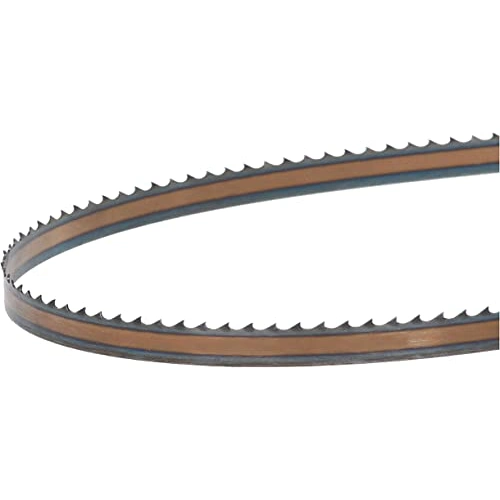
Designed for Resawing and Crosscutting
The Timber Wolf blade is an ideal accessory for larger band saws that need to make a high volume of rip cuts, especially in thicker stocks of hardwood or softwood. This blade tracks straight and provides a clean and efficient cut, even on large pieces of wood.
With the unique 5 TPI set pattern, you get better chip clearance, so your blade lasts longer. The blade’s positive claw tooth style helps it easily handle green wood and resaw thick stock.
Various TPI for Different Woods
The resawing blade comes in various sizes with various teeth per inch for different widths and wood thicknesses. This blade’s standard size is 93.5 inches long and 1/2 inch wide, with 4 teeth per inch with a positive claw tooth style.
It has a kerf of .042 and a 6.5-degree tooth angle. The blade’s cut radius is 2-1/2 inches, making it suitable for ripping and crosscutting.
Excellent Cutting Curves
This resaw bandsaw blade is versatile enough to work with curves and contours in wood, providing clean and smooth cuts at every turn.
These bandsaw blades have a 6.5-degree rake angle, which minimizes vibration and improves stability. You’ll find the bandsaw blade easy to control with minimal drift angle, making it easy to cut curves easily.
Pros:
- Cuts hardwood with ease
- Thinner kerf for less waste
- Suitable for cutting curves with minimal drift angle
- Tracks straight and provides clean cuts consistently
- High-quality bandsaw blade for resawing and crosscutting
- The unique 5-tooth set pattern provides excellent chip clearance
Cons:
- May require adjustments to track true on tires
- Not suitable for cutting metal or ceramics
#3 Jet Bandsaw Blades for Resawing
Are you looking for a bandsaw blade that easily cuts through thick green wood and hard woods? Check out the Jet bandsaw blades for Resawing, flex-back construction, and precision-milled for aggressive cutting.
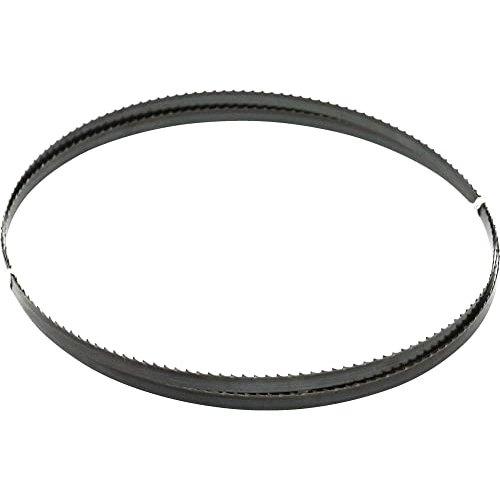
Precision-Milled Teeth for Aggressive Cutting
JET saw blades for resawing deliver precision cuts because they have carefully-milled teeth designed for aggressive cutting. These teeth are welded and induction-hardened to guarantee long-lasting performance of the highest quality.
Flexback Construction for Durability
Another key feature of these blades is their flashback construction. It absorbs contour-cutting stresses and is an excellent fatigue factor. So they’re also built to last and can handle regular use.
Cutting Curves Capabilities for Thick Stock
These bandsaw blades can resaw hard and softwoods up to 8 inches thick. This makes them suitable for various projects, including Adirondack chair parts from softwoods and construction-grade projects like framing a house with 2×4. Also, the blades can cut curves with ease.
Compatibility with Larger Bandsaws
JET resaw bandsaw blades are designed to fit the JWBS-14SFX bandsaw but are also compatible with larger bandsaws. As a result, they’re a versatile option for people with multiple saws.
Pros:
- Superior sharpness
- Long-lasting durability
- Can resaw up to 8 inches thick piece
- Easy installation
- Compatible with JWBS-14-SFX JET bandsaws
- Ideal for cutting curves and smooth lines
Cons:
- Leaves some blade marks on cut wood
- Not suitable for craft style woodworking
#4 Wood-Mizer Sawmills Bandsaw Blades for Resawing
If you need a blade that handles thicker wood stock and hardwoods, Wood-Mizer Sawmills Bandsaw Blades can handle it. Since they’re versatile, you can use them with bigger bandsaws for tougher projects.
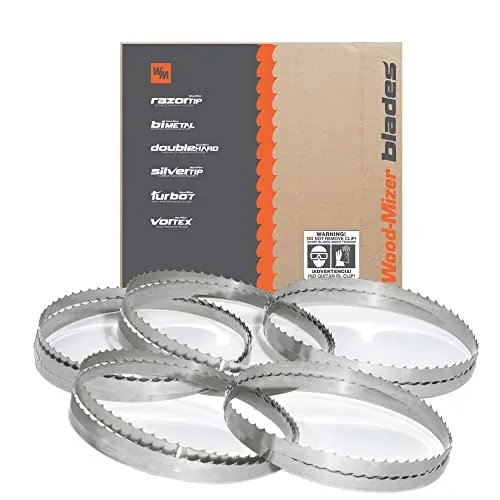
High-Alloy Steel for More Power
The DoubleHard high-alloy steel blade offers more power in cutting through hardwoods and thicker stock than standard carbon steel. With twice the sharp life, it delivers a smoother cut every time.
All-Purpose Hook Angle
This 10° all-purpose hook angle bandsaw blade is efficient for sawing mixed wood species and cutting curves. It can easily adapt to the wood of varying densities and grains, making it a versatile addition to your bandsaw blade collection.
Versatile Cutting
With its 0.042 x 1-1/4 sawmill and bandsaw blade thickness x Width and 7/8 Tooth Spacing, the bandsaw blades can easily handle thick stock. It resharpens with CBN Grinding Wheel, ensuring it remains sharp and ready for the next job.
Thrust Bearings Improve Stability
These bandsaw blades fit larger bandsaws, making them perfect for larger projects. Also, thrust bearings improve accuracy and stability, minimizing drift angle for a smoother, straighter cut.
Pros:
- DoubleHard High-Alloy Steel maintains sharpness twice
- Can handle thick stock and hardwoods
- All-purpose hook angle for cutting curves
- Improved thrust bearings stability
- Good price for a pack of 5 blades
Cons:
- May require cutting to fit some saws
#5 Laguna Carbide Resaw Bandsaw Blades
Upgrade your woodworking game with the Laguna Carbide Resaw Bandsaw Blades. Made with a patent-pending design and carbide tips, these blades ensure clean cuts, reduce sanding time and deliver top-notch performance.
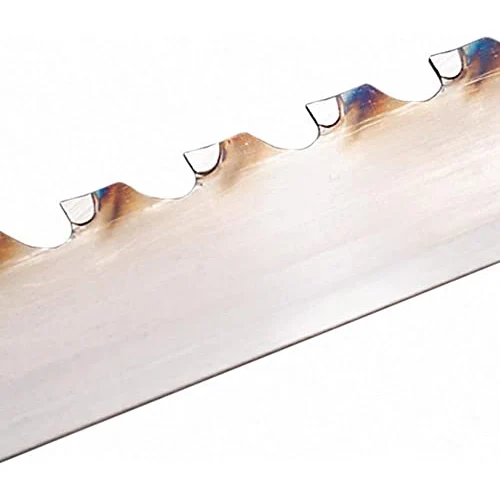
Powerful Carbide-Tipped Blade
The Laguna carbide-tipped blade for resaw carbide tips that enable faster cutting and smoother cuts. Also, small kerfs mean less material is wasted, and you get more out of your hardwood stock.
Say Goodbye to Blade Drift
Blade drift is a common issue regarding resawing, but not with the Laguna carbide-tipped resaw Blades. With its anti-kickback feature and innovative design, this blade provides a straight cut with no drift, giving you a table saw-like finish every time.
Great for Working with Cypress
This bandsaw blade is suitable for standard hardwoods and works great with cypress. The 12mm, 14mm, and 16mm pitch options and 2-3 variable TPI make it easy to adjust the bandsaw blade to match the wood you’re working with.
Pros:
- Provides clean cuts and shortens sanding time
- Has an anti-kickback feature and no blade drift
- Suitable for a variety of hardwoods, including cypress
- Faster cutting, smoother cuts, and small kerf
Cons:
- Requires careful alignment for best results
Best Resaw Blades for Bandsaw: Comparison Table
| Name | Blade Specifications | Cutting Application | Cutting Material Thickness |
| Olson Saw FB23193DB | 1/2″ x 0.025″ x 93-1/2″ 3 TPI | Resawing | Hard or soft wood, plastic, mild steel, non-ferrous metal |
| Timber Wolf 144711 | 1/2″ x 93-1/2″ 4 TPI (Positive Claw) | Ripping, Crosscutting, Resawing | Kiln-dry hardwood: 2-1/2″ – 6″, softwood: 1-1/2″ – 4″ |
| Jet WBSB-116124 | TPI 116″ x 1/2″ x 4 | Resawing | Up to 8″ thick hard and softwoods |
| Wood-Mizer B27514410S-5 | 0.042″ x 1-1/4″ with 7/8″ tooth spacing | Sawmill applications, Resawing | Sawing mixed wood species |
| Laguna RKD-075-105 | Carbide blade | Resawing | Up to 5″ thick hard black walnut wood |
How to Choose the Best Bandsaw Blade for Resawing Hardwood?

You can maximize your time and resources by selecting the appropriate bandsaw blade for resawing hardwood. This task can be overwhelming with various blade materials, types, widths, and tooth configurations.
To choose the best bandsaw for an accurate cut, you need to consider these things:
Blade Material
To make sure your resawing cuts are smooth and long-lasting, choose a blade made of high-quality carbon steel or carbide-tipped materials. Carbon steel blades are durable and affordable, while carbide-tipped blades offer a longer lifespan and are better for harder woods.
Consider the type of wood you’ll cut and how often you’ll use the saw when selecting a blade material. A good blade material will result in cleaner, smoother cuts and less wear on your saw.
Tooth Configuration
When looking for the best bandsaw blade for resawing, consider blades (such as a wood slicer blade from Highland Woodworking) with a wide width, low tooth count, and skip-tooth configuration.
Skip-tooth blades have every other tooth missing, providing better chip clearance and reducing sawdust buildup. This is critical for resawing as sawdust accumulation can lead to overheating, burning, or breaking of the blade.
You should pay attention to the tooth pitch along with the tooth configuration. Depending on your needs, you can choose a larger pitch to cut faster or a smaller pitch for a smoother finish. The gullet depth, or space between teeth, should allow ample chip clearance.
Blade Width
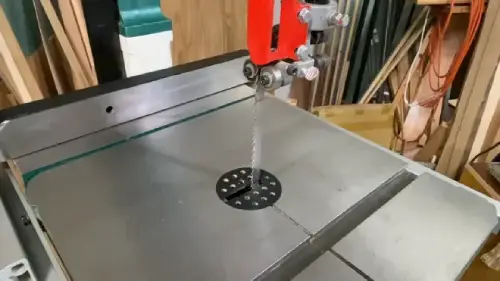
If you want to resaw wood with ease, choosing the right blade width is crucial. A wider blade will provide stability and straighter cuts. Therefore, going for a blade at least 1/2′ wide is recommended.
This width can handle the stresses of resawing, resulting in smoother and more accurate cuts. A wider blade also helps to distribute the pressure evenly, which reduces the possibility of the wood bending or warping during the cutting process.
Also, the wider blade will create less friction and heat, which will increase blade life and reduce the risk of burning the wood.
Blade Thickness
When choosing a blade thickness for resawing, it’s like finding balance on a tightrope. You need to decide on the right thickness for stability and efficiency while considering material waste.
Thicker blades offer more stability and reduce bending, resulting in straighter cuts. They’re more rigid, which lessens blade flexing during cutting. However, thicker blades also have wider kerfs, leading to more material waste.
Finding a balance between the blade thickness and kerf size is vital for desired cut quality and efficacy. Consider the material you’re cutting when choosing a blade thickness. Thicker materials such as hardwoods, require a thicker blade for stability, but veneers can use a thinner blade to reduce kerf waste.
Blade Type
Using a blade specifically designed for resawing can make a big difference. For optimal results, skip-tooth or variable-tooth blades are often recommended. These blades have larger gullets to help remove sawdust efficiently and avoid clogging during cutting.
Skip-tooth blades are missing every other tooth, which reduces friction and heat generation during cutting. They’re best suited for thick and hardwood. Conversely, variable-tooth blades have teeth that vary in size and spacing. This design reduces vibrations and produces a smoother cut.
Blade Hook Angle
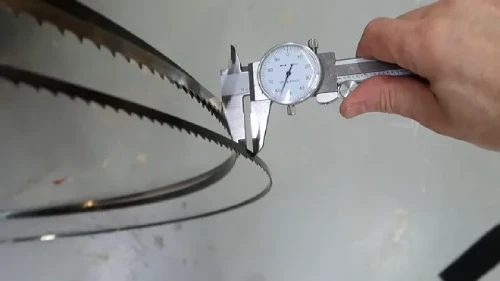
The hook angle is between the tooth face and a line perpendicular to the blade. A blade with a positive hook angle has teeth that lean forward, making it ideal for thicker or harder woods as it removes material quickly.
But this can also result in a rougher surface finish, which may require additional sanding or planing. A lower hook angle or a variable tooth blade could be a better option for a smoother finish.
A blade with a lower hook angle leans back, resulting in a less aggressive cutting action and a smoother finish. But a variable tooth blade combines different hook angles on the same blade, providing a balance between cutting speed and surface finish.
Blade Drift Compensation
Blade drift causes uneven and inaccurate cuts, but many band saws have features to adjust the fence or compensate for blade drift. This allows you to align the fence with the blade’s drift angle, resulting in straight and accurate cuts.
To compensate for blade drift, adjust the blade guides and thrust bearings. These components keep the blade on track, preventing it from moving side to side or forward and backward. Use a fence with adjustable positioning to achieve accurate and precise cuts every time.
Tension and Tracking
Before starting a resawing job, properly tension and track your bandsaw blade. Refer to the manual for guidance on tensioning the blade to the appropriate level to achieve smooth cuts and prevent machine wear and tear.
Check the blade tracking to ensure it remains on the wheels during use and prevents blade drift. Choose components tailored to the blade and saw for the best quality cuts. Quality guides and bearings significantly affect the final product’s accuracy.
Guides and Bearings:
To prevent the band saw blade from wandering during cuts, adjust the guides and bearings properly. Position the thrust bearings close to the blade, while the guides should be set behind the gullets.
Ensure that the thrust bearings only touch the blade under tension, and the guides are as close as possible to the blade without touching it. This way, you’ll achieve straighter cuts during resawing.
What bandsaw blade is recommended for resawing?
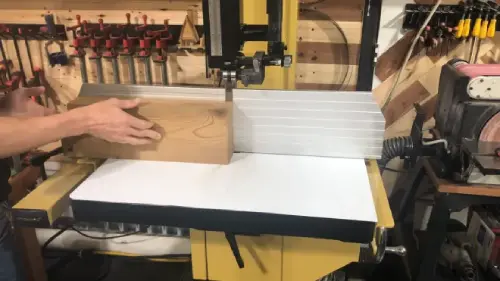
Use a blade with fewer teeth per inch to maximize your resawing than cross-cutting or cutting curves. For most 14′ band saws, a 1/2′ wide blade with 2-3 TPI is a good choice. But why does the TPI matter for resaved?
Here are five reasons why blades with fewer TPI are recommended for resawing:
- It helps to reduce the chance of the blade overheating and potentially breaking.
- Blades with less TPI cuts more aggressively, making the process quicker and more efficient.
- The wider gullets of the blade allow for better chip removal, which helps to avoid clogging and burning the wood.
- Blades with fewer teeth per inch can handle thicker pieces of wood with ease, resulting in a straightener & smoother cut.
- The larger tooth spacing on the blade reduces the amount of sawdust produced, making the process cleaner and more manageable.
Is a wider bandsaw resaw blade better for resawing?
A wider bandsaw blade for resaw is generally better for resawing. This is because it provides more beam strength, which promotes straighter and more accurate cuts.
The wider the blade, the more beam strength it has. This means that a wider blade can resist bending or wobbling while cutting through thick pieces of wood, resulting in a smoother and straighter cut.
But remember that the width of the blade should also be appropriate for the size of the bandsaw you’re using. A bandsaw with a smaller saw motor may not be able to handle a wider blade, which could result in poor performance and possibly even damage to your bandsaw.
Are carbide-tipped blades worth considering for resawing?

Consider blades with carbide-tipped teeth for enhanced durability and longer blade life during resawing. They may be more expensive initially but can save you money in the long run.
Carbide-tipped blades are made with a high-quality tungsten carbide material, making them more wear and tear-resistant. This means that the blade will last longer before it needs to be replaced.
These blades also offer superior cutting abilities compared to regular steel blades. They can easily handle tougher materials like hardwoods, dense lumber, and even some metals. Also, the carbide tips on the blade provide better accuracy and precision during cuts.
Mastering Resawing: Carefully Choose the Perfect Bandsaw Blade
Bandsaw blades must be selected carefully for resawing. Because there are a bunch of factors to consider, including the blade material, the tooth configuration, the blade width, and the thickness. Understanding how each element contributes to effective and efficient resawing is essential.
Whether you opt for a carbon steel blade or a carbide-tipped one, a wide blade with a low tooth count is generally recommended for resawing. By keeping these tips in mind and following the manufacturer’s guidelines for tension and tracking, you can ensure a smooth and accurate resawing experience.
Although all the products mentioned above are top-of-the-line, Olson Saw’s TPI hook saw blades are the best. These resawing blades feature a hook design of 3 TPI for quick and accurate cutting. Aside from that, no special expertise or tools are required for setup.
